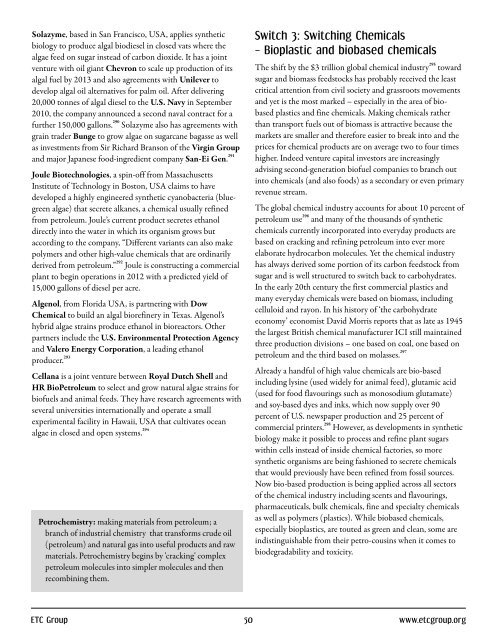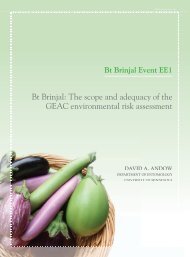English - pdf - 2145 Kb - Biosafety Information Centre
English - pdf - 2145 Kb - Biosafety Information Centre
English - pdf - 2145 Kb - Biosafety Information Centre
- No tags were found...
You also want an ePaper? Increase the reach of your titles
YUMPU automatically turns print PDFs into web optimized ePapers that Google loves.
Solazyme, based in San Francisco, USA, applies syntheticbiology to produce algal biodiesel in closed vats where thealgae feed on sugar instead of carbon dioxide. It has a jointventure with oil giant Chevron to scale up production of itsalgal fuel by 2013 and also agreements with Unilever todevelop algal oil alternatives for palm oil. After delivering20,000 tonnes of algal diesel to the U.S. Navy in September2010, the company announced a second naval contract for afurther 150,000 gallons. 290 Solazyme also has agreements withgrain trader Bunge to grow algae on sugarcane bagasse as wellas investments from Sir Richard Branson of the Virgin Groupand major Japanese food-ingredient company San-Ei Gen. 291Joule Biotechnologies, a spin-off from MassachusettsInstitute of Technology in Boston, USA claims to havedeveloped a highly engineered synthetic cyanobacteria (bluegreenalgae) that secrete alkanes, a chemical usually refinedfrom petroleum. Joule’s current product secretes ethanoldirectly into the water in which its organism grows butaccording to the company, “Different variants can also makepolymers and other high-value chemicals that are ordinarilyderived from petroleum.” 292 Joule is constructing a commercialplant to begin operations in 2012 with a predicted yield of15,000 gallons of diesel per acre.Algenol, from Florida USA, is partnering with DowChemical to build an algal biorefinery in Texas. Algenol’shybrid algae strains produce ethanol in bioreactors. Otherpartners include the U.S. Environmental Protection Agencyand Valero Energy Corporation, a leading ethanolproducer. 293Cellana is a joint venture between Royal Dutch Shell andHR BioPetroleum to select and grow natural algae strains forbiofuels and animal feeds. They have research agreements withseveral universities internationally and operate a smallexperimental facility in Hawaii, USA that cultivates oceanalgae in closed and open systems. 294Petrochemistry: making materials from petroleum; abranch of industrial chemistry that transforms crude oil(petroleum) and natural gas into useful products and rawmaterials. Petrochemistry begins by 'cracking' complexpetroleum molecules into simpler molecules and thenrecombining them.Switch 3: Switching Chemicals– Bioplastic and biobased chemicalsThe shift by the $3 trillion global chemical industry 295 towardsugar and biomass feedstocks has probably received the leastcritical attention from civil society and grassroots movementsand yet is the most marked – especially in the area of biobasedplastics and fine chemicals. Making chemicals ratherthan transport fuels out of biomass is attractive because themarkets are smaller and therefore easier to break into and theprices for chemical products are on average two to four timeshigher. Indeed venture capital investors are increasinglyadvising second-generation biofuel companies to branch outinto chemicals (and also foods) as a secondary or even primaryrevenue stream.The global chemical industry accounts for about 10 percent ofpetroleum use 296 and many of the thousands of syntheticchemicals currently incorporated into everyday products arebased on cracking and refining petroleum into ever moreelaborate hydrocarbon molecules. Yet the chemical industryhas always derived some portion of its carbon feedstock fromsugar and is well structured to switch back to carbohydrates.In the early 20th century the first commercial plastics andmany everyday chemicals were based on biomass, includingcelluloid and rayon. In his history of ‘the carbohydrateeconomy’ economist David Morris reports that as late as 1945the largest British chemical manufacturer ICI still maintainedthree production divisions – one based on coal, one based onpetroleum and the third based on molasses. 297Already a handful of high value chemicals are bio-basedincluding lysine (used widely for animal feed), glutamic acid(used for food flavourings such as monosodium glutamate)and soy-based dyes and inks, which now supply over 90percent of U.S. newspaper production and 25 percent ofcommercial printers. 298 However, as developments in syntheticbiology make it possible to process and refine plant sugarswithin cells instead of inside chemical factories, so moresynthetic organisms are being fashioned to secrete chemicalsthat would previously have been refined from fossil sources.Now bio-based production is being applied across all sectorsof the chemical industry including scents and flavourings,pharmaceuticals, bulk chemicals, fine and specialty chemicalsas well as polymers (plastics). While biobased chemicals,especially bioplastics, are touted as green and clean, some areindistinguishable from their petro-cousins when it comes tobiodegradability and toxicity.ETC Group 50 www.etcgroup.org











